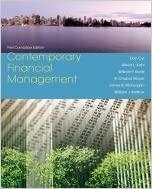Answered step by step
Verified Expert Solution
Question
1 Approved Answer
Fin Security analysis & Portfolio MNGMT 11) You are a risk-averse investor whose coefficient of risk aversion (A) 2.0. Your risk preferences are described by
Fin Security analysis & Portfolio MNGMT 

11) You are a risk-averse investor whose coefficient of risk aversion (A) 2.0. Your risk preferences are described by the following quadratic Expected Utility Function Expected Utility of Portfolio E[Return on Portfolio]-0.5A times Variance (Portfolio) Use the following data, to answer questions a and b below. EXPECTED RETURN 10% 2296 7% SECURITY 15% 40% 0 Risk-free asset Correlation (A, B)-0.25 Coeff of Risk Aversion (A 2.0) a) How would you allocate your investment budget between the risky securities A and B to form an Optimal Risky Portfolio, i.e., the Sharpe Ratio-maximizing portfolio? b) What is the expected return and variance of the Optimal Risky Portfolio? c) Given the allocation weights found in part (a), what are the allocation weights that would produce the optimal portfolio, i.e., Expected-Utility Maximizing, containing securities A, B, and the risk-free security? Note this portfolio is also called the "Complete Portfolio 

Step by Step Solution
There are 3 Steps involved in it
Step: 1

Get Instant Access to Expert-Tailored Solutions
See step-by-step solutions with expert insights and AI powered tools for academic success
Step: 2

Step: 3

Ace Your Homework with AI
Get the answers you need in no time with our AI-driven, step-by-step assistance
Get Started


